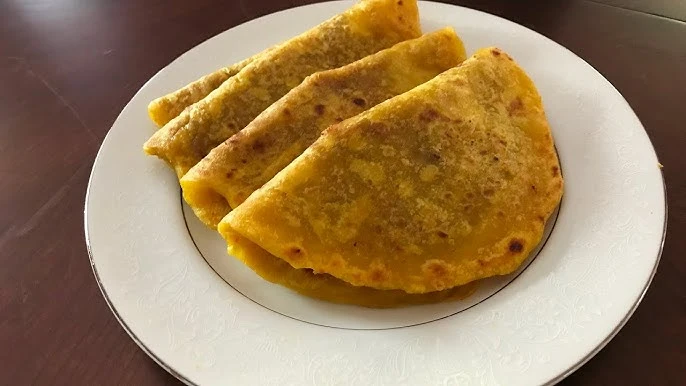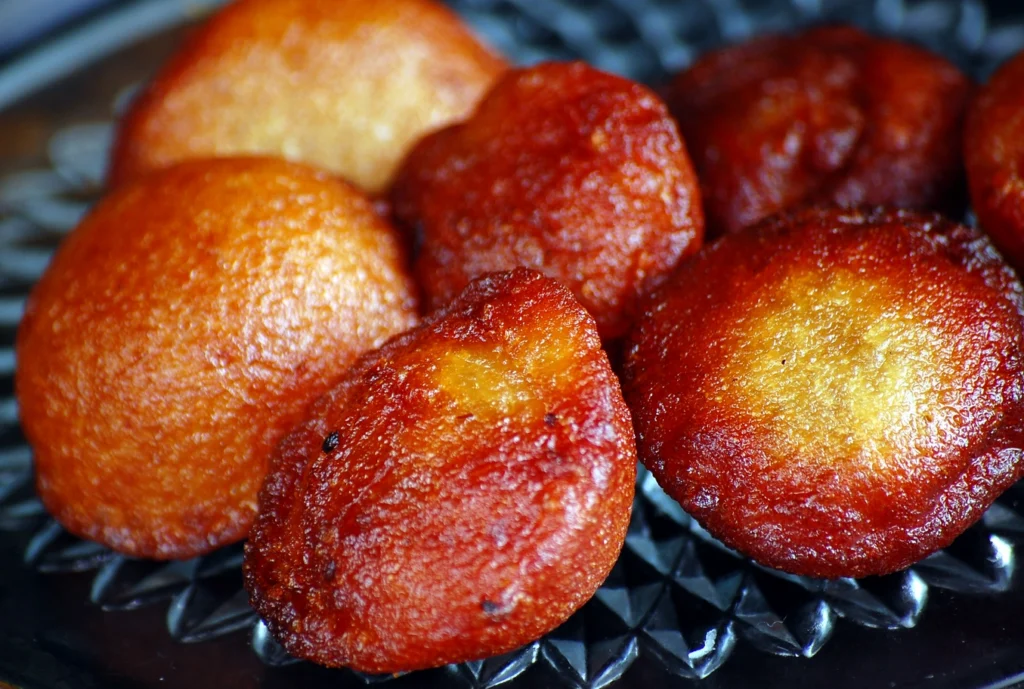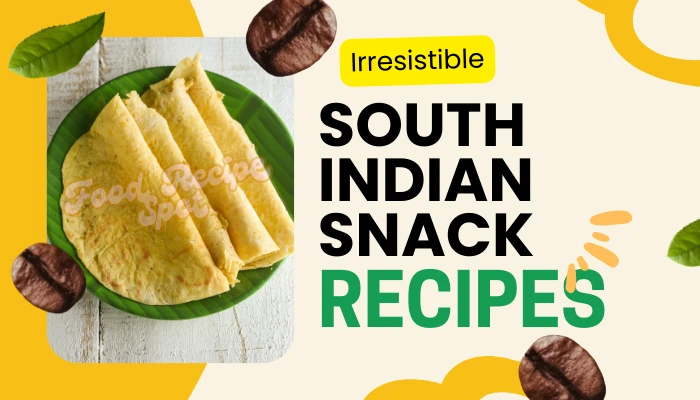1. South Indian Snacks – Boli
Boli, a sweet… An authentic recipe. This recipe makes 6 bolis.
Ingredients
- Turmeric, salt – A pinch each
- Flour – 1 cup + extra, to dust and 1/3 cup water, to knead
- Bengal gram (Chana dal / “Kadala Parippe”) – ½ cup
- Ghee – 3 tbsp, to roast
- Cardamom powder – 1 tsp
- Nutmeg – A pinch, finely powdered
- Sugar – 1 cup, or to taste
- Gingelly oil – 3 tsp

Process
- Soak Bengal gram for 10 minutes. Pressure-cook for 6 whistles with 2 cups water. Let cool and blend into a fine paste form.
- Mix flour, turmeric, salt and water so that it forms a soft dough.
- Next, pour gingelly oil over the ball. Knead lightly. Keep aside.
- In a wok, cook the Bengal gram with sugar until dry. Sprinkle cardamom, nutmeg. Stir well.
- Form 6 balls with the dough.
- Take each ball.
- Pat into a thin, even/uniform circle in your palm and place the filling, covering the whole area, folding all the ends to form a ball.
- On a floured surface, place the ball. Roll into thin circles, dusting with flour when necessary, so that the filling is evenly distributed throughout the surface.
- Lightly roast on a heated skillet seasoned with ghee.
- Serve hot with a cup of hot cocoa. Keep refrigerated.
Tip: Boli - An old, fool-proof recipe
2. Unniappam
A low-fat, low-sweet Appam, made with unrefined wheat flour (“Atta”) in under half an hour. It is a remarkably simple non-greasy item.
Ingredients
- All-purpose wheatflour – 1½ glass
- Cardamom – 1 tsp, crushed
- Beige jaggery (“ Ache Sharkara”) – 1 block
- Yellow plantain (“Nendrapazham”) – 1, ripe
- Cooking oil/ coconut oil – ¼ cup
- Water – 1 glass

Process
- Cube and puree the banana in a blender.
- In a pan, keep the jaggery and water and bring to a boil until the jaggery is all melted.
- In a bowl, combine all ingredients, except oil.
- Add liquid if required to get a batter of pouring consistency.
- Set aside for 15 minutes.
- Keep the Appam mould on the hob.
- Pour 2 spoons of oil in each circular groove.
- Wait until oil begins to bubble.
- Use a teaspoon to fill each of the semi-circular grooves with the batter.
- As the mixture cooks over gentle heat, you will find that the oil seeps onto the edges.
- The batter will puff up so that the appam’s final look resembles a ping-pong ball.
- Over low heat, fry the appam until the base of the ball looks nice golden all over.
- With a skewer, tip it over onto the other side.
- So now, the upper crust part is cooked.
- Once it is light honey tinged in hue, remove and place in a colander lined with kitchen tissue paper.
- Serve hot or warm for tea…
Tip : For the Unniappam, use ripe plantains “nendrapazham”.
3. Pooada/ Chakka Ada
Ada is one of the most traditional sweetmeats of Kerala, situated in the southern peninsula of the Indian sub-continent. The recipe makes 2 dozen adas, [13 regular jaggery-coconut combo adas and 11 Chakka/ jackfruit adas.]
Ingredients
- White rice – 2 cups
- Desiccated coconut – 2 cups
- Salt – ¾ level tsp
- Cardamom powder – 1 tbsp
- Dark brown jaggery – 2 cups
- Coconut oil – 2 tbsp
- Dried ginger powder – 1 level tsp (optional)
- Unsalted butter/ ghee – 1 tsp
- Plantain leaf `Ila / ela’ – 3 nos.
- Sweet jackfruit jam / compote / Chakka Varattiyathe – 1 cup + Grated coconut – ½ cup
Process
- Wash and soak the white rice in a bowl of water for two hours. Drain and reserve the liquid.
- Run the rice with surface level water (used to soak) for about 2-½ to 3 minutes on maximum speed. It should not be watery at all.
- You will obtain a smooth, thick white batter, akin to idli-dosa batter.
- In a saucepan, melt the jaggery in ¼ cup water until melted. Once it boils, pass through a hand-held metal sieve into a vessel. Add the freshly grated coconut.
- If using frozen grated coconut, microwave for 35 seconds in a microwavable Pyrex bowl.
- Tip in the coconut. Cook for 2-3 minutes until the mixture is thickened. Add cardamom and dried ginger powder.
- Toss in a teaspoon of butter. Stir and remove from fire. Keep this mixture warm.
- If it thickens, add a teaspoon of water at room temperature and heat slightly. On stirring, it will loosen up again.
- Now, heat water in a big vessel, say the idli cooker.
- Take each plantain leaf. Keep the plantain leaf with the pointy end to your left and the flat, broad end to the right. Wash thoroughly without causing tears on its delicate, tender surface. If you like, you can snip off the pointed end and any dark edges on the margins of the leaf.
- Using a kitchen scissors, go over the plantain leaf across the stem vertically so as to make 4 sections equidistant (through the stem.) Wash each segment well.
- In the vessel of water on a rolling boil, keep all the plantain sheafs. Immerse for 5 minutes. You will see the mint, light green turning to a darker olive shade of green. This process is called “ela vaattuka”.
- Another method is to pass a whole (washed and dried) plantain ila over a flame in one swift stoke without any burning or charring. The green will have a co-mingling of black and brown tinges. Now, scoop it out with a perforated ladle onto a platter.
- First, snip off the stem rod and you will be left with 2 plantain leaflets respectively.
- Take a kitchen towel, keep a leaf in your hand and wipe both sides dry using delicate gentle strokes.
- Once this process is complete, keep a bowl of coconut oil at hand. Take a leaflet.
- Using the inner side, mark three vertical dots and wipe the entire leaflet with your hand in a single stroke. A thin film of coconut oil is formed.
- Do so with all the leaflets, stacking them one on top of the other. Carefully, peel each one for use, so these do not tear.
- Take the rice batter. Add salt and give a few good stirs.
- On each ila piece, add a tablespoon of the rice batter. The batter should form a neat circle and must not seep on to the edges.
- Add a tablespoon of the jaggery coconut mixture in the centre.
- Simply fold in half.
- Make a diagonal fold to the opposing untouched sides and fold in the untouched rim. Invert and place on the steamer rack.
- You can use a two-tier steamer or a traditional idli cooker for steaming purposes.
- Boil the water at the base. Ensure that there is enough water to last 20 minutes.
- Place all the prepared leaf parcels in circular rows and close the lid.
- Cook for 20 minutes on medium flame and leave untouched, unopened for 15-20 minutes.
- After the stipulated time, take each ada out and arrange on a platter. Serve hot and fresh as breakfast, with teamed bananas and plantain chips or as a tea-time indulgence.
- For the chakka adas, mix the jaggery sweet compote and coconut, desiccated and microwave for 30 seconds together. Stir well. Use as the jaggery filling. Mix in any leftover jaggery stuffing.
- Another method is to mix the rice batter with enough jaggery compote, coconut and to proceed as stated above. Serve fresh, piping hot with tea!
Tip: Pooada and Chakka Ada are best, served immediately, hot.

1 thought on “3 Irresistible South Indian Snacks: You Must Try!”